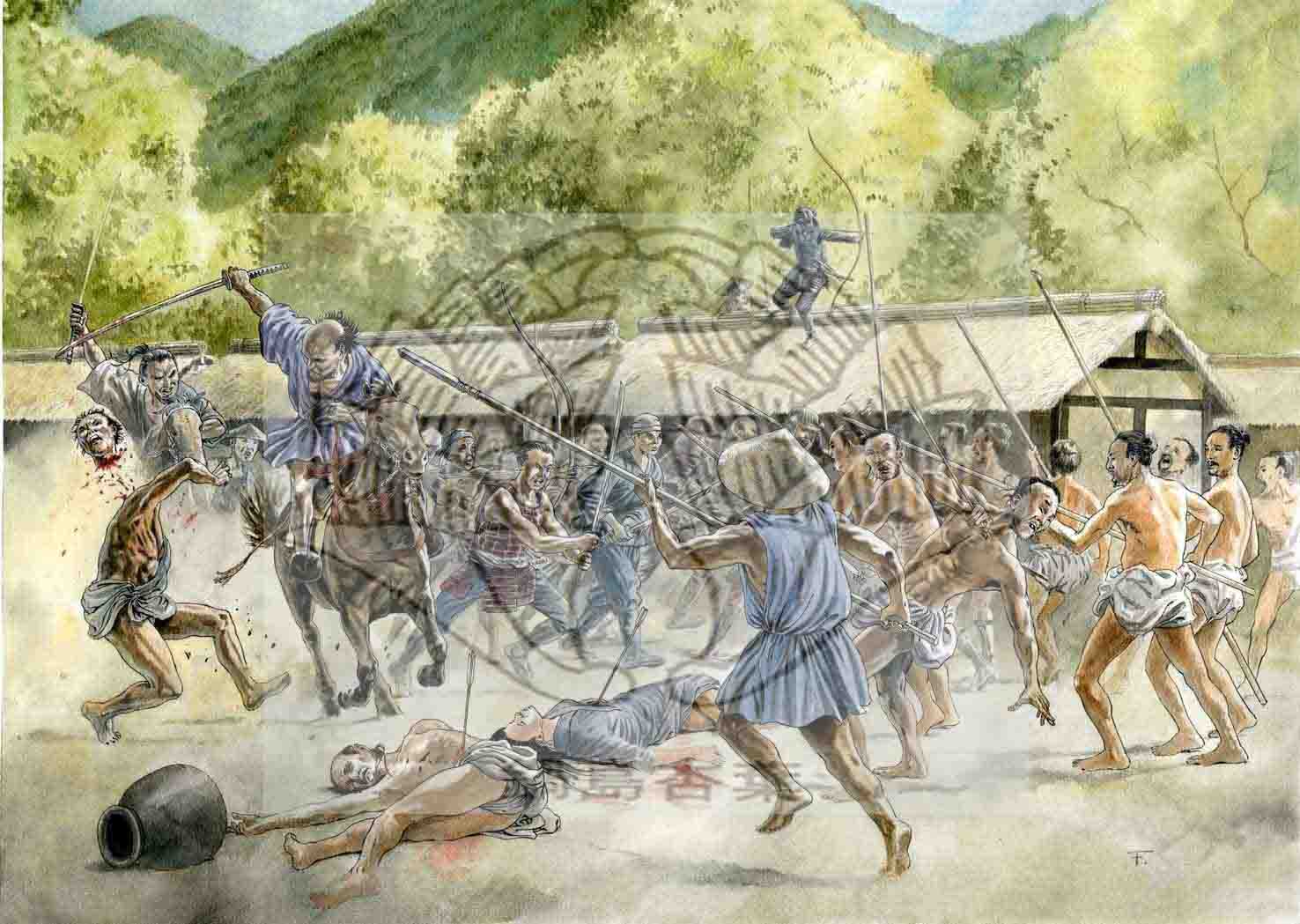The Battle of Takatenjin Castle
The Battle of Takatenjin Castle (1580-81)
In Japan there is evidence, archeological and through documents, of more than 30 000 castles, fortifications and fortified manors. In some areas and districts there was a castle on every hill and mountain, and often with a manor at the foot of the mountain where the fortress lay.
Why was it like this, or was it necessary for this huge number of fortifications on these relative isolated islands?
Well to say it quite plainly, the majority of these fortifications came about due to the outbreak of hostilities between local lords, protection against bandits, and civil unrest.
The fortifications were either on a mountain, a hill or in many cases of the later period (end of the Sengoku period – early 1600s) a so-called lowland castle, and when on lowland it had huge stone walls and often water-filled moats all around the outer perimeter, as well as the second compound and sometimes even the main compound – called the honmaru in Japanese.
The early form of a mountain castle was a relatively, or seemingly, hastily constructed fortification made up of wood and bamboo – although some stone could have been used in the building’s foundations and in the gatehouse, and as a base for the wooden wall on the outer barricade. There was no plaster on the walls of the early castles, as in the later fortifications, during for example, the 16th and 17th century – those that we tend to look upon when talking about castles of Japan.
The real boom in building fortifications throughout the Japanese islands occurred during the 14th century – during the Nanbokuchô Period (1333-1392). This period is known as the “The War Between The Two Courts” – which turned the country into a seemingly never-ending destructive civil war, and the need to build strongholds became imperative to safeguard one’s own territory and protect one’s people. Large traces of fortifications from this period today are almost nonexistent, new castles were often built upon ruins of old ones, if the location was still of strategical importance – this could change as the lord’s territories expanded. New hills and mountains were then investigated and from a strategically point of view reviewed, all this in order to find the best place for a new fortification.
Although a lot of new castles were built, during the 15th century old castles and fortifications remained for the large part, as they were. That is to say – they continued to serve as a base for the ruling clan and protection against enemies – both foreign and domestic.
The Sengoku Jidai (The Country at War Period)
In the 16th century one can say that there was something resembling a volcanic eruption on castle-building – although, many of these were just small wooden forts, sometimes only 50 to 100 meters in area – as their total area. These are often called tsumejiro or tsukejiro (support castles/forts) and were used both in defensive and offensive operations. Some were made by the attackers and some by the defenders. One such siege and battle will be presented in the next chapter – the battle for Takatenjin Castle of 1580-81. In 1574 the castle was captured by the Takeda clan and as the struggle and war for Tôtômi province, between the Takeda and Tokugawa, continued, Takatenjin became an important base to control. Ieyasu gradually got the upper hand on Takeda Katsuyori and during the year of 1580 he decided the time was right to close the chapter on Takatenjin.
The Siege and Battle for Takatenjin Castle in 1580-81
On the 22nd of October 1580, Ieyasu’s army had reached Takatenjin Castle. The army had advanced southeast from Hamamatsu towards Yokosuka, and then further east towards Takatenjin, located in Tôtômi province. To the south of the castle, on a small hill called Mitsuizan, Ieyasu ordered a fortress to be constructed – just opposite Takatenjin Castle. Mitsuizan was a perfect place to erect a fortification, the hill had three natural water-springs, used as wells, and on all sides the hill had more or less natural defensive lines. From the east side, running south, there was a large valley, making this a natural defensive moat. On the northeast side there were huge cliffs with steep sides making sure that this side is also effectively protected. The hill, with its cliffs, made it perfect as a lookout position, so all in all a very good location for a fortress. Ieyasu had a great base for further advances against Takatenjin. But he wanted more, and in all five (or six) more fortifications were constructed on hills in a semi-circle line around the southeast, east, and northeastern side, all facing Takatenjin; Ogasayama (2,5km from Takatenjin), Nakamura Shiroyama, Nogasaka, Higamine, Shishigahana and Kazefuki – all these other fortifications were closer to Takatenjin than Ogasayama. The intention and completion of these fortifications was in order to prevent the encircled forces to sally out, and also to hamper any rescue force from entering the castle. In fact, already in March of this year, Ieyasu had been in this area, and on that occasion his forces erected three fortifications around the enemy base-castle, but nothing more came out of it.
This time Ieyasu was determent to take this enemy bastion, and his men started to build a fence and to dig a dry moat all around the castle – this in order to keep the defenders inside. In addition to the fences and fortifications facing Takatenjin, a large fence on top of the dry moat was constructed, on the opposite side of the fortifications facing outwards – this in order to fend against a possible rescue force from Takeda Katsuyori.
Ieyasu made preparations for a long siege, and if necessary he would wait long enough to starve the defenders into submission – this seemed to be his preliminary plan. Ieyasu himself made camp at Mamushizuka (Mabusezuka), about 8km northwest of Takatenjin, while the rest of the army was located in various positions around the enemy castle.
Takatenjin Castle
The history of Takatenjin Castle before the Tokugawa and Takeda started their struggle over it is rather sparse. The castle is said to have been constructed sometime around 1416, when the Kyûshû tandai (Kyûshû commissioner), Imagawa Ryôshun became shugo (guardian) over Suruga and half of Tôtômi province. According to the story Ryôshun encouraged Imagawa Norimasa to build a castle in this area, and so Takatenjin Castle came to be. Might be a true story, but there is a lack of well-founded evidence for this. Much more believable is the theory that it was sometime during the invasion of Tôtômi province by Imagawa Ujichika and his general Ise Sôzui (Hôjô Sôun) at the end of the 1400s (probably sometime between 1492 and 1504). During Ujichika’s invasion and subsequently territorial gain of parts of the province the castle of Takatenjin came to be, and if so was the case, it might have been Ujichika’s general Fukushima Masashige who supervised it. One thing is clear though, the castle went through many changes in its appearance from its beginning and up to the time of the Takeda and Tokugawa conflict. It was in fact more or less two castles that were at one time linked up and formed now a huge castle. It was quite a large castle in 1580 – measuring from north to south 1500 meter, and west to east 1000 meter. If one goes roughly straight north from the castle one would end up in Kakegawa, and if one turned the opposite way, to the south – about 4km, one would reach the ocean. This castle was guarding the area south of Kakegawa and the seaside-road leading from Yokusuka Castle in the west towards the east up to Koyama Castle, located at the Tôtômi-Suruga border, close to Ôi River.
The Commander
In October 1580 it was Okabe Masayuki (or Naganori, or Nobumoto, various sources on who commanded the castle) who commanded the approx. 1000 defenders on Takatenjin Castle, his second in command was Yokota Tadatoshi (Tadamatsu). Masayuki belonged to the Okabe family which served the Takeda. The family was part of the Suruga sakikata-shû (Suruga country units). Masayuki had first served with the Imagawa and then with Takeda Shingen, and from 1573 Shingen’s son Katsuyori. He was an experienced and brave commander and when the Tokugawa army showed up at his doorstep – he was far from intimidated. Already in June of this year, 1580, the enemy army had terrorized this area by burning down villages and destroying everything they got their hands on.
The Siege
In all Ieyasu had brought with him about 11,000 soldiers on this campaign, and now his various divisions were placed around the castle’s outer defenses – guarding. Ieyasu commanded the largest force of 3000, and then follows Honda Tadakatsu with 2500, Sakakibara Yasumasa 2500, Torii Mototada 1000, Ôsuka Yasutaka 750, Ishikawa Yasumichi 500, Honda Yasushige 500, and Sakai Shigetada 250. But total idleness until the enemy eventually surrendered was not the case; the soldiers were ordered to set the area’s farmhouses on fire and cut down the rip rice in the fields around the castle. Ieyasu wanted to make sure that the enemy would be cut off completely from any food and other supplies that would help them to endure the siege for a longer period. Ieyasu had made the necessary preparations for a long siege. Strong fortifications guarded towards the castle, and against enemy reinforcements that might appear from the north and east, in the form of Takeda Katsuyori.
The siege started from the moment the Tokugawa army arrived outside the walls of Takatenjin Castle. That is to say, around the middle of October 1580. Fortifications were built and moats and palisades were made, in addition also the barbwire of the Middle Ages – branches and sharpened twigs that were placed in front of the palisades, and in the moat and just as often on the edge of the moat. All of these preparations in order to hamper the attacker in his advance. On the other hand, the attacker used shields, large and small handheld kinds, in order to approach as near as possible without getting hit, and then he would launch an attack when he was close enough.
Ieyasu had no intentions of an all-out attack on the castle’s defenses, so instead the army sat down around the castle’s outer walls and moats. He also ordered soldiers to stand guard around the whole castle’s outer defenses, in fact a soldier was placed every 1,8 meter around the whole enemy fortification.
New Year was approaching and everything was quiet at the front. Then on January the 3rd Ieyasu was informed that a force under the command of Takeda Katsuyori was approaching. Oda Nobunaga got the same information and he immediately sent Mizuno Tadamoto and Mizuno Tadashige in the lead with forces from Ôno in Owari with them towards Yokosuka Castle. So now the Tokugawa army had received reinforcements, and it would be even harder for the besieged army, or for that matter any rescue army from Takeda, to lift the siege. Nothing more came of the rumor about a Takeda rescue-force – the castle’s defenders were left to fend for themselves.
In February Ieyasu wanted to give the defenders a chance to surrender. Ieyasu knew that the defenders had very little food, and rumors about them picking grass and other foliage as food reached the ears of Ieyasu. He sent them a proposal, giving them permission to leave the castle unharmed. If this is historical correct, and in fact really happened, is unknown. Anyway, if there was a proposal from Ieyasu, the defenders must have declined – because the final chapter was just a few weeks away, and it was not a peaceful conclusion.
Ieyasu gave the order to prepare for a final assault. He moved his camp to Yokosuka, and from there he supervised the preparations. He strengthened the forces around the enemy castle, because the starving defenders might try to sally out, a few at a time during the night, or maybe a large scale attack. Ieyasu wanted to be prepared for every probability.
The final attack came on the 22nd of March, in the evening, but it is not that easy to understand what really happened – the sources are a bit diffusing on the sequence of events. It seems that in the evening of the 22nd the enemy sallied out in a desperate attempt to break the siege, or maybe as a last fight to their death – it was the latter. According to the source “Shinchô kôki” in all 688 soldiers of various rank joined the commander of the castle in a desperate attack out onto the besiegers, and they were killed. In Matsudaira Ietada’s diary “Ietada nikki”, the following can be found; “among our own we lost about 130 in total, while the enemy lost more than 600”. In the original source the information can be somewhat more difficult to understand than my version of translation.
There are a few words and sentence structures that can be a bit confusing – even for Japanese historians. There is a word “Asuke” with the kanji character of “shû” (means unit) after it, and I believe this is to be understood as “the unit from Asuke” (a place in the northern part of Mikawa province). If one can understand it like that, it would read something like this; “from the unit of Asuke the losses were 130, while the enemy lost more than 600”.
One source has the following to say about the final battle: “The defenders were divided into two groups, and one group sallied out in westward direction towards the Hayashi Valley, where the units under Ôkubo Tadayo’s command were standing. The other group stormed out towards Ishikawa Yasumichi’s position more to the east. Here to all the desperate soldiers were killed.” In fact, if the rumors are true, not all of the defenders were killed, according to some sources a few managed to escape – among these we find Yokota, the second-in-command of Takatenjin Castle.
To follow up his victory, Ieyasu ordered his men on the 23rd to search the area for any remaining enemies. While his men searched the area for any escapees, Ieyasu entered personally Takatenjin Castle to inspect the formidable fortress. When it could be ascertained that the area was safe and the castle was firmly in their possession, Ieyasu ordered the main bulk of the army to return to their respective castles. On the 24th Ieyasu returned to his Hamamatsu Castle.
From this day on Takatenjin Castle served as a support and base castle in this area of Tôtômi province, but when Ieyasu moved to the Kantô area in 1590 – Takatenjin became abandoned.
This example of a siege and battle at Takatenjin is typical of many of the military campaigns during the Sengoku Period. An invading army lay siege to a castle, either they tried to take the castle within a few days or it turned into a long and tiresome siege – sometimes tiresome for both sides. In the end the besieged army might succumb to starvation or thirst and surrender, or they try a desperate last attack – a so-called suicide-attack. The third option is that the besieging army storms the castle when the defenders are too exhausted to defend. There is even another option, sometimes the attackers give up and continue their campaign somewhere else or they retreat. During the most part of the 16h century in Japan there was one such military action every other day.
Sources (all in Japanese)
Ieyasu-den. By Nakamura Kôya. Kôdansha Tokyo 1970.
Sengoku no jô ge. By Nishigaya Yasuhiro. Gakken Tokyo 1992.
Sengoku no Tatakai, Kantô Tôkai hen. Gakken Tokyo 1996.
Shinchô Kôki. Transl. By Kuwada Tadachika. Shinjinbutsu Tokyo 1997.
Takatenjin jissenki. By Utô Mitsuo. Shizuoka 1995.
(and many more)





